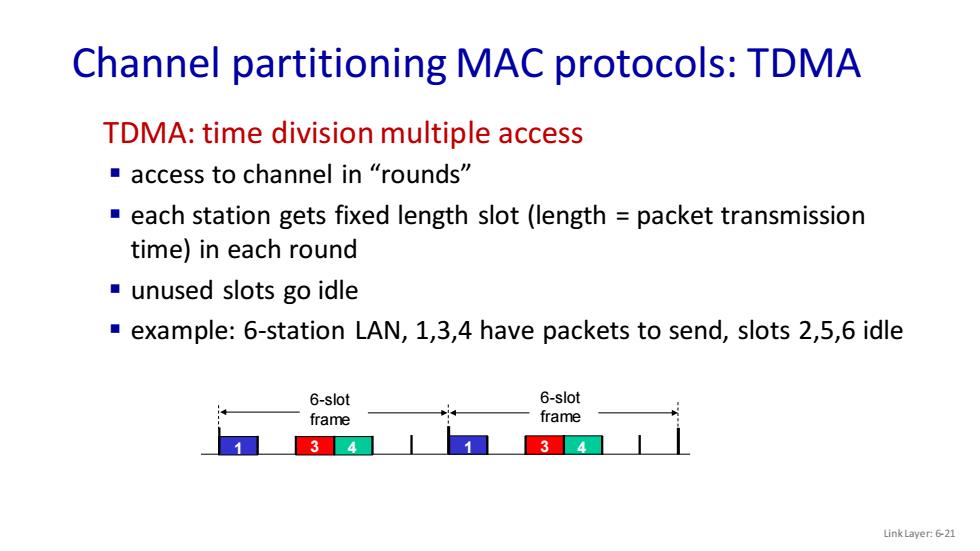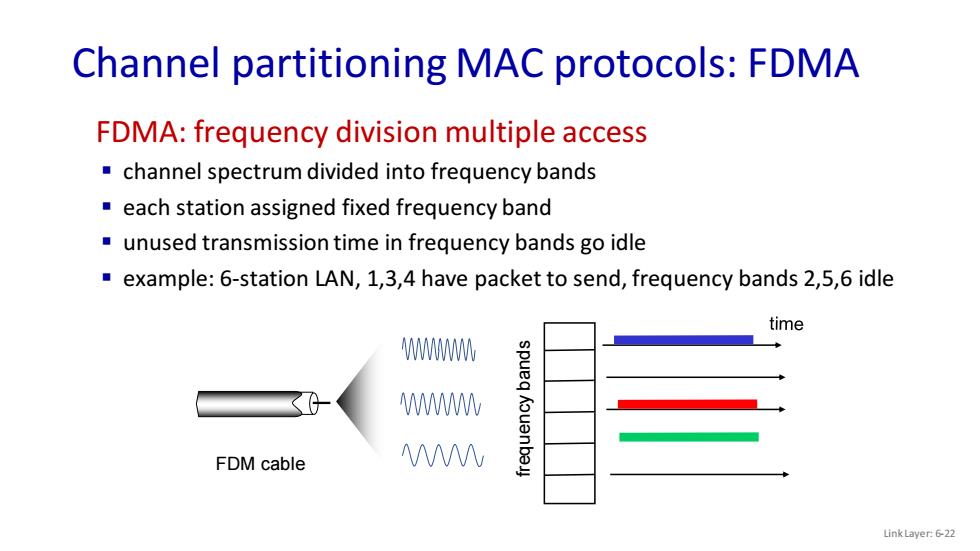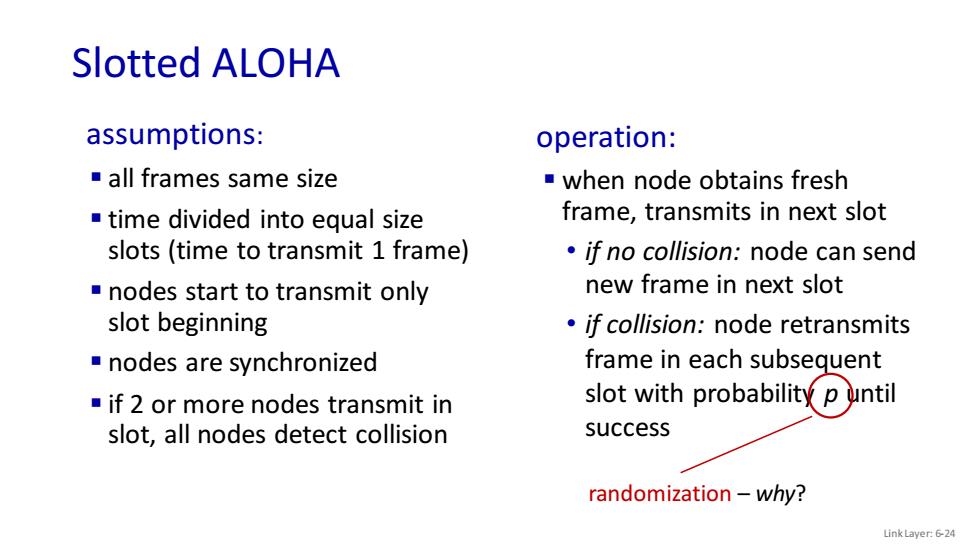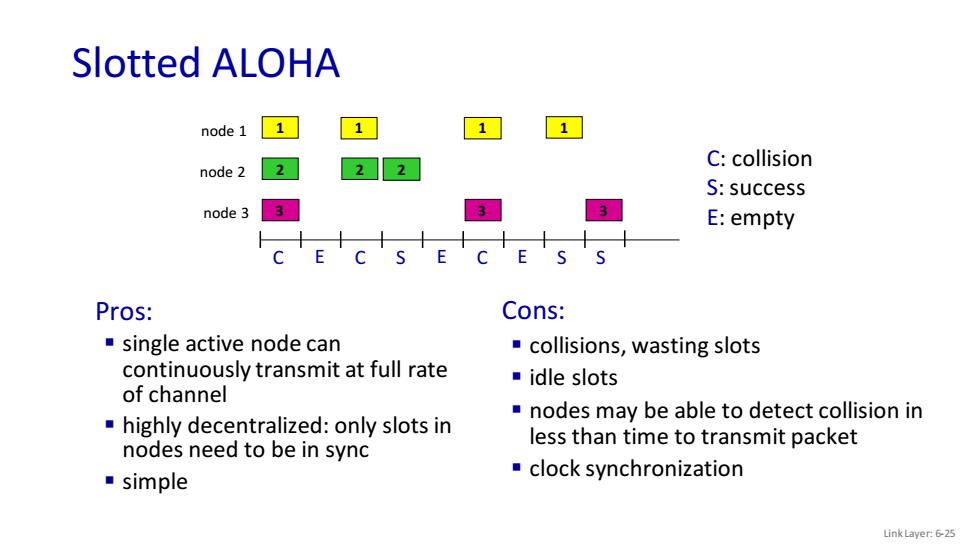
Channel partitioning MAC protocols:TDMA TDMA:time division multiple access ■access to channel in“rounds" each station gets fixed length slot(length packet transmission time)in each round ■unused slots go idle example:6-station LAN,1,3,4 have packets to send,slots 2,5,6 idle 6-slot 6-slot frame frame 3 Link Layer:6-21
Channel partitioning MAC protocols: TDMA Link Layer: 6-21 TDMA: time division multiple access ▪ access to channel in “rounds” ▪ each station gets fixed length slot (length = packet transmission time) in each round ▪ unused slots go idle ▪ example: 6-station LAN, 1,3,4 have packets to send, slots 2,5,6 idle 1 3 4 1 3 4 6-slot frame 6-slot frame

Channel partitioning MAC protocols:FDMA FDMA:frequency division multiple access channel spectrum divided into frequency bands each station assigned fixed frequency band unused transmission time in frequency bands go idle example:6-station LAN,1,3,4 have packet to send,frequency bands 2,5,6 idle time WM M FDM cable Link Layer:6-22
Channel partitioning MAC protocols: FDMA Link Layer: 6-22 FDMA: frequency division multiple access ▪ channel spectrum divided into frequency bands ▪ each station assigned fixed frequency band ▪ unused transmission time in frequency bands go idle ▪ example: 6-station LAN, 1,3,4 have packet to send, frequency bands 2,5,6 idle frequency bands FDM cable

Random access protocols -when node has packet to send transmit at full channel data rate R. no a priori coordination among nodes ■two or more transmitting nodes:“collision" random access MAC protocol specifies: how to detect collisions how to recover from collisions (e.g.,via delayed retransmissions) examples of random access MAC protocols: ·ALOHA,slotted ALOHA CSMA,CSMA/CD,CSMA/CA Link Layer:6-23
Random access protocols Link Layer: 6-23 ▪ when node has packet to send • transmit at full channel data rate R. • no a priori coordination among nodes ▪ two or more transmitting nodes: “collision” ▪ random access MAC protocol specifies: • how to detect collisions • how to recover from collisions (e.g., via delayed retransmissions) ▪ examples of random access MAC protocols: • ALOHA, slotted ALOHA • CSMA, CSMA/CD, CSMA/CA

Slotted ALOHA assumptions: operation: ■all frames same size when node obtains fresh time divided into equal size frame,transmits in next slot slots (time to transmit 1 frame) if no collision:node can send nodes start to transmit only new frame in next slot slot beginning if collision:node retransmits nodes are synchronized frame in each subsequent if 2 or more nodes transmit in slot with probabilityp until slot,all nodes detect collision success randomization-why? Link Layer:6-24
Slotted ALOHA Link Layer: 6-24 assumptions: ▪ all frames same size ▪ time divided into equal size slots (time to transmit 1 frame) ▪ nodes start to transmit only slot beginning ▪ nodes are synchronized ▪ if 2 or more nodes transmit in slot, all nodes detect collision operation: ▪ when node obtains fresh frame, transmits in next slot • if no collision: node can send new frame in next slot • if collision: node retransmits frame in each subsequent slot with probability p until success randomization – why?

Slotted ALOHA node 1 1 C:collision node 2 2 S:success node 3 E:empty Pros: Cons: single active node can collisions,wasting slots continuously transmit at full rate ■idle slots of channel nodes may be able to detect collision in highly decentralized:only slots in nodes need to be in sync less than time to transmit packet clock synchronization simple Link Layer:6-25
Slotted ALOHA Link Layer: 6-25 Pros: ▪ single active node can continuously transmit at full rate of channel ▪ highly decentralized: only slots in nodes need to be in sync ▪ simple Cons: ▪ collisions, wasting slots ▪ idle slots ▪ nodes may be able to detect collision in less than time to transmit packet ▪ clock synchronization 1 1 1 1 2 3 2 2 3 3 node 1 node 2 node 3 C E C S E C E S S C: collision S: success E: empty